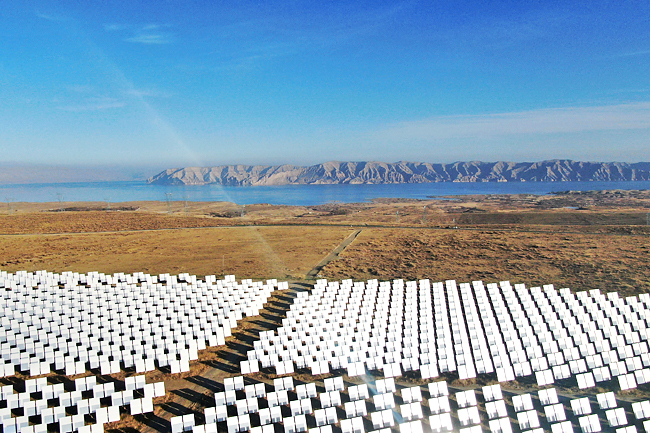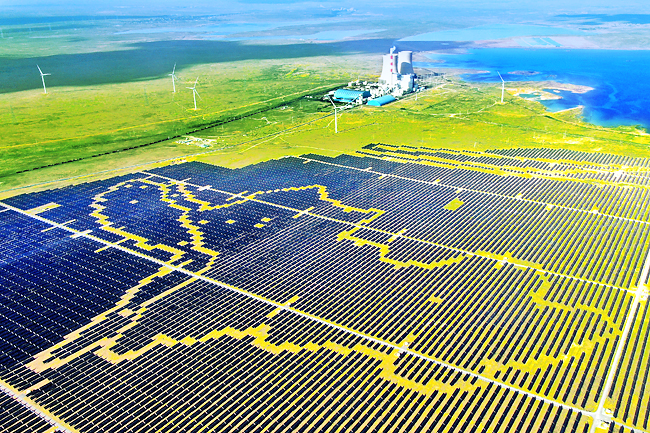XINHUA – In northwest China’s Gobi Desert, two neighbouring power plants testify to an ongoing clean energy transition in the country’s west-to-east power transmission system.
Yuanyanghu, one of China’s largest thermal power stations, stands out with its 200-metre-high cooling towers. A railway goes directly into the plant, supplying more than 20,000 tonnes of coal a day. Its vast expanse of coal storage looks like undulating hills.
Last year, the plant in Ningxia Hui Autonomous Region generated 16.8 billion kilowatt-hours (kWh), which travelled more than 1,000 km to power up manufacturing plants in the eastern provinces of Shandong and Zhejiang.
Now, about 10 minutes’ drive from the thermal behemoth, a new photovoltaic power station has emerged to herald the low-carbon and high-tech future of this power relay.
The Ningdong photovoltaic base is maintained by fewer than 100 people and a fleet of automatic-inspection drones, which helped reduce the facility’s environmental impact. Built on a coal-mining subsidence area, it is also equipped with a smart system to monitor subsidence, the legacy of underground mining, so as to timely draft maintenance plans.
The plant exports 3.6 billion kWh of solar power every year through west-to-east power transmission. Though the output is not on par with its coal-firing neighbour, similar solar stations are popping up in the area in greater numbers.


“It sets an example for revitalising coal mining subsidence area for new-energy production,” said engineer with the Ningxia branch of CHN Energy Investment Group (CHN Energy) Shu Maolong, the constructor of the base.
Over a decade since it joined the national project of channelling the surplus electricity in the west to the power-hungry east, the coal-rich Ningxia is switching to clean energy amid the country’s drive to peak carbon dioxide emissions by 2030.
Boasting the ninth largest coal reserve in the nation, the small provincial region has supplied 650 billion kWh of thermal power to other parts of the country since 2011 through two cable networks. Its power exports helped satisfy east China’s appetite for affordable electricity, while generating more than 60,000 jobs and revenue of CNY160 billion (USD22.5 billion) locally.
In recent years, Ningxia has leveraged its abundant wind and solar resources to build a clean-energy industry. By June, the installed new-energy capacity had reached 37 million kW to account for over half of the regional total.
The rise of new energy has redefined the power transmission to the east. In the first half of this year, Ningxia exported 43 billion kWh of power, including nearly 10.6 billion kWh of new energy. Representing a year-on-year increase of 120 per cent, the export of new energy is equivalent to reducing carbon dioxide emissions by 8.91 million tonnes, according to Ningxia’s electricity transaction centre.
Ningxia is now building its third cable network to export solar and wind energy to central Hunan Province. Its completion, scheduled for next year, is expected to further raise the region’s installed new-energy capacity to 60 million kW.
POWERING UP THE GREEN TRANSITION
According to this year’s government work report, in 2023, China’s installed renewable energy capacity surpassed its thermal power capacity for the first time in history, and China accounted for over half of newly installed renewable energy capacity worldwide.
Like Ningxia, the clean-energy industry is taking off in China’s less-developed west, where the total installed capacity of new energy has surpassed 400 million kW and is continuing to rise.
In Qinghai, a vast plateau province to the west of Ningxia, the installed capacity of renewable energy had reached about 51.1 million kW by the end of 2023, accounting for 93 per cent of the province’s total installed capacity.


